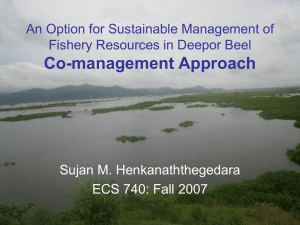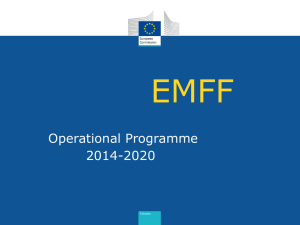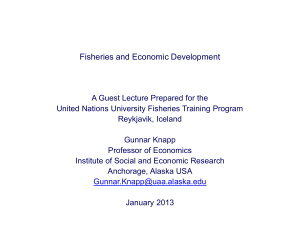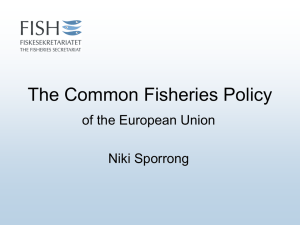Processed Fishery Products Roadmap
advertisement
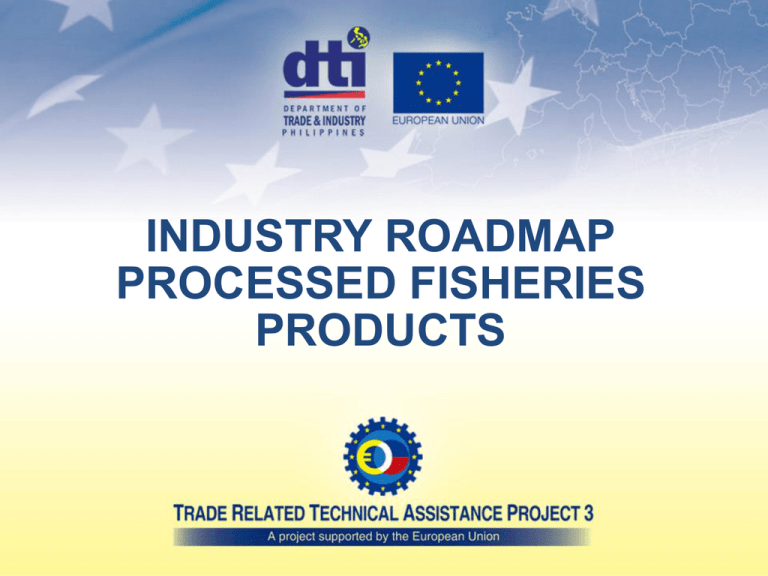
INDUSTRY ROADMAP PROCESSED FISHERIES PRODUCTS The Philippines ranks 12th among top world fish-producing countries. In 2013, fishery industry’s contribution to national GDP was 1.9% WEF Competitiveness Report 2013-2014, ranked the Philippines in 59th place among 148 countries. www.eutrta3phils.org Aquaculture is the largest sub-sector In 2013, aquaculture contributed 42.46% of fishery output in volume Municipal fishery followed with 30.32% Commercial fisheries contributed with 27.22% www.eutrta3phils.org Fishery industry suffers from “inadequate quality fisheries infrastructure and cold chain” facilities, which limits its competitiveness in the region. Domestic cold chain (warehousing and specialized storage facilities) is among the most important fisheries services but present provision is unsatisfactory and needs improvement. Constraints such as internal transportlogistics, import-export clearance, certification, permit processes, transparency and non-tariff measures, still exist. www.eutrta3phils.org In 2013, fishery production reached MT 4,7 million against a production of MT 4,9 Million in 2012 (-3.1%). Contribution to food security of Small Pelagic Fishes (SPF) is positive, but dominant species stocks (Scads, Sardines and Anchovies) are declining, as the Philippines have exceeded the Maximum Sustainable Yield (MSY). The MSY of capture fishery production of SPF is estimated at 550,000 MT per year. www.eutrta3phils.org The majority of the Philippine fish processing plants meet international standards in terms of product quality, styles of pack and packaging. Value-added products in the form of fillets, locally comminuted or minced products, such as fish balls, fish sausages, squid balls, are growing in demand www.eutrta3phils.org The export-oriented processing plants have improved their processing practices, equipment, hygiene and sanitation. However, their present provision needs improvement. The problem is critical to exporters of frozen fish who need adequate freezing and warehousing and specialized storage facilities to maintain the high quality of their exported products. www.eutrta3phils.org Overall, domestic logistics services in the fisheries supply chain are considered as inadequate in terms of expertise, capacity, and overall service quality. Release of imported perishable goods at customs is delayed by 33% in terms of time between the arrival of goods and storage, due to disputes in classification and valuation. www.eutrta3phils.org Certification and permit facilities are available at some major fishing ports, but remains the need for putting up laboratories in some regional offices of BFAR. A problem related to Non-Tariff Measures (NTM) in the Philippines is the inability of exporters to meet international food safety standards for fisheries products due to high costs of compliance. www.eutrta3phils.org Additional investment in the construction and proper maintenance of port quality infrastructure and cold chain are considered as highly necessary by the fishery industry. Solutions to address these problems are challenging and are currently being addressed by the competent authorities, such as DTI-BOI, DA, BFAR, PFDA, DOST and LGUs. www.eutrta3phils.org Weaknesses of the Fishery Industry can be classified into industrial, socioeconomic, political and institutional. Industrial Weaknesses Low fish production Underutilization of fisheries resources Over-exploitation of some fishing grounds Proliferation of illegal fishing Lack of ice plants and cold storage facilities Lack of effective organizational and extension machinery Poor delivery and dissemination of technological packages www.eutrta3phils.org Socio-economic Weaknesses Inequities in access to resources, opportunities and sources Political Weaknesses Unequal, inadequate and poor delivery of government services Lack of intervention of local officials especially during site selection, endorsement and implementation of a fishery project www.eutrta3phils.org Institutional Weaknesses Poor accessibility to institutional support e.g. technical, extension, information and financial support. www.eutrta3phils.org INDUSTRY ROADMAP Processed Fishery Products www.eutrta3phils.org Under Philippine Development Plan 2011-2016, BOI has been mandated to partner with the private sector in implementing activities to develop industries including in the formulation and implementation of sectoral roadmaps. www.eutrta3phils.org The Processed Fishery Products Roadmap engages multi-stakeholder participation, and incorporates a process whereby Government, the private sector, and fishers, all work together to specify and implement agreed improvements in how the fishery is managed. www.eutrta3phils.org The Industry Roadmap for Processed Fishery Products will cover the following products a. Bivalve b. Sea Urchin c. Squid Fishery Value Chain Analysis Value chains are concerned with what the market will pay for a product or service offered for sale. A fishery value chain describes a model of how fishery businesses receive raw materials as input (captures and culture fisheries), add value to the raw materials through various processes, and sell finished products to customers. Value chains of pelagic fish in most Asian developing countries are not developed to meet international market requirements and limited value addition. www.eutrta3phils.org Importers Processors Fishermen Retailers Retail Chain Export Types of Fishery Value Chains Fishermen Export Processors Wholesaler Fishermen www.eutrta3phils.org Processors Export Retailers Export Retail Chain Importers Fishermen Export Processors Wholesaler www.eutrta3phils.org Export Retailers Importers The value chain in the Philippine fishery is composed by a combination of governance structures. Market-based governance based more on trust and mutual understanding than on formal business practices. Balanced governance involves Fishermen’s Organizations (FOs) which coordinate with supermarkets on behalf of their members to market their fish products Directed governance is prominent in the domestic marketing channel involving the Community Fishery Centres (CFC) and in the exports marketing channel Hierarchical governance focuses on the institutional arrangements (agreements, rules, rights, laws, norms, roles and procedures) In the Philippine fishery value chain, vertical linkages from primary producers (fishermen/aquaculture farmers) via wholesaler to processor, indicating that wholesalers play an important role in the marketing channel. www.eutrta3phils.org PROCESSED FISHERY PRODUCTS SWOT ANALYSIS Strengths (1) • • • • • • • • • • Extensive fishery production capability Extensive coastline. Fisheries areas are located along a rich and varied coastline Proximity to regional markets with high demand Significant percentage of commercial, municipal fisheries and aquaculture output Global image and expectations: aquaculture is widely seen as the main future source of seafood security, as long as it can continue to develop sustainably Diversity of commercial species, being fished at sustainable levels Underexploited stock of pelagic species Significantly high yields and good profitability in some sectors Stronger linkages with the international markets Good international reputation of some Philippine processing companies, that are increasingly providing high quality, certified and traceable products to the national and international seafood markets www.eutrta3phils.org PROCESSED FISHERY PRODUCTS SWOT ANALYSIS Strengths (2) • The processing companies are technically innovative, and there is further capacity for the sector to modernise and consolidate through the use of modern technology, leveraging significant extension work • High awareness levels on price trends and customer needs • Improved post-harvesting technologies available to most fishers and processors • Gradual reduction of middlemen in the procurement system • Gradual reduction of wastage due to better road/rail and refrigeration infrastructure • Widespread organized fish retailing, demanding higher quality produce • Strong entrepreneurship and self-reliance is inherent in coastline communities • Experienced, flexible and adaptable workforce in fishing, with young entrants starting come through in some areas a regular basis • Aquaculture has technically innovative, well-trained staff • Continuity of quality, specification and price of supply of aquaculture production • Consolidated ability to plan predictable production • Good profitability and increasing productivity in some aquaculture sector • Increasing capacity for capital investment / growth in parts of the fishing and aquaculture sectors • Willingness to consider diversification within the fishing sector www.eutrta3phils.org PROCESSED FISHERY PRODUCTS SWOT ANALYSIS Weaknesses (1) • • • • • • • • • • • • • • • • • Outdated harvesting technologies Inadequate information and market ignorance on prices, trends and customer needs Inadequate post-harvesting facilities (ice, cold storage and cooler wagons) Traditional, agent-driven, inefficient procurement system Extremely poor transportation (roads, harbours, auction halls, market places and logistics) Infrastructure (lack of ice production, very limited cold storage facilities) High degree of wastage (poor handling and grading) Produce inconsistent inequality Outdated, inadequate distribution of infrastructure Limited organized fresh produce retailing High degree of wastage MSY management made difficult because of mixed fisheries Exports constrained by inadequate cold storage infrastructure and high costs Economic difficulties are being faced by some parts of the fleet The Philippines have an aging fleet, with fuel inefficiencies Limitations on aquaculture sites Economic challenges for the aquaculture sector, therefore difficulty to obtain funding including working capital www.eutrta3phils.org PROCESSED FISHERY PRODUCTS SWOT ANALYSIS Weaknesses (2) • • • • • • • • • Perception of poor support, understanding by some public sector policy and regulatory bodies with respect to aquaculture Aquaculture is vulnerable to health / disease / water quality challenges Some fisheries areas face a decline of traditional fishing industries and skills retention, and residents tending to out-migrate for work Fisheries areas are in general quite distant from markets and costs are high The processing sector continues to include a small number of large multi-unit businesses, and a larger number of small, single unit businesses The supply chain and transport logistics can be difficult for some parts of the processing sector, and transport costs can be significant High costs in processing, especially energy The processing sector is dependent on affordable and (locally / regionally) available raw materials Financial weaknesses include high cash flows, low financial literacy levels, low savings culture, large operations outside the formal financial systems, weak financial functions, heavily dependence on informal (unreliable) financial sources, poor business management skills, weak community organization with high levels of political interventions, vertical power imbalances (governance), low yields, production scattered over many small-scale fishermen, farms www.eutrta3phils.org PROCESSED FISHERY PRODUCTS SWOT ANALYSIS Opportunities • • • • • • • • Growing demand / need for seafood in Europe and other key markets such as China, India and Russia, which can take production from Philippine fisheries and aquaculture. The vision for Philippine fisheries is that it can transition into a sector that can sustainably supply the market, making use of improved management through reform and other measures, based upon good science, good regulations and upon the inherent capacity of the marine ecosystem to recover. Innovation and support can assist that transition, including technical, cost-reduction, valueadding and supply chain efficiency developments. Diversification opportunities within the fisheries industries are seen as important. A priority for aquaculture development in the Philippines relates to new production opportunities and technologies, especially for more exposed sites in the marine environment. This requires coordinated support from regulatory bodies. As working capital is a serious issue for SME aquaculture business (compared with fisheries), the prospect of support via financial institutions would help unblock this constraint is an important opportunity. Co-location with or diversification into other marine industries is a potential road forward for the Philippine aquaculture industry. High quality research can help unblock constraints for Philippine aquaculture and in the fisheries sector as a whole. Fisheries areas will benefit from stability, profitability and growth in the commercial and municipal fisheries and in aquaculture sectors. www.eutrta3phils.org PROCESSED FISHERY PRODUCTS SWOT ANALYSIS Threats (1) • Fisheries areas, because of their very nature, are subject to the threats that apply to the fisheries and aquaculture sectors • Fisheries areas are geographically widespread and some of them are relatively isolated: increasing costs for transport would be a threat • Processing is also challenged by threats relevant to Philippine fisheries and aquaculture, but in addition is subject to additional external threats such as cheaper imports of processed seafood. • Political will to develop exports • Emergence of new competitors • More stringent requirements for product quality • Depletion of stocks www.eutrta3phils.org PROCESSED FISHERY PRODUCTS SWOT ANALYSIS Threats (2) • Costs could continue to increase faster than prices increase, leading to decreased profitability in the commercial and municipal fisheries sector – and equally applicable to aquaculture • MSY targets and discard bans could prove to be overly costly for parts of the Philippine fisheries, affecting profitability and therefore economic sustainability • On medium and long term, competition for space in the marine environment and climate change effects could impair fishing opportunities for Philippines’ vessels. • The economic climate in market nations could reduce sales prices for Philippine fisheries, aquaculture and processed products • Beyond cost increases and price declines, the greatest immediate threat to all parts of Philippine aquaculture is from diseases, parasites, invasive non-native species, and human health issues such as norovirus. • Growth in Philippine aquaculture production is threatened by: a) lack of technical innovations allowing new profitable business opportunities to be developed / exploited; b) lack of policy and regulatory support for understanding the sector and its requirements, and c) lack of investment capacity, especially for loan capital. www.eutrta3phils.org Thank you! www.eutrta3phils.org

